This Whole Wheat Tartine bread is similar to Tartine Country Bread, but is made with a greater proportion of whole wheat flour to white flour – about 85% whole wheat.
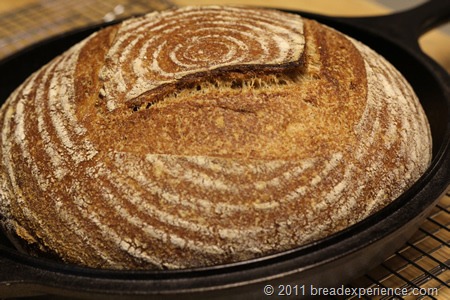
My bread is sweet and nourishing, made from my own wheat, ground in my own mill, and baked in my own oven.
Tobias Smollett, Humphrey Clinker, 1771
This Whole Wheat Tartine Bread is my contribution to World Bread Day 2011.
Equipment used to make this bread:
- Lodge 3.2 Quart Dutch Oven/Combo Baker
- Banneton Proofing Basket
- Wire Whisk
- Danish Dough Whisk
- Small and large Mixing Bowls
Whole Wheat Tartine
Adapted from: Tartine Bread by Chad Robertson
Makes: One 2-pound loaf
Ingredients:
- 400 grams water (plus a couple of tablespoons)
- 100 grams leaven
- 350 grams whole wheat flour (I used home-milled flour from hard red winter wheat)
- 150 grams all-purpose flour (I used a 50/50 blend of whole wheat and white all-purpose flour)
- 10 grams salt
Directions:
Making the Leaven: The night before you plan to mix the dough, take 1 tablespoon of a mature starter and feed it with 200 grams of warm (78 degrees F) water and 200 grams of a blend of 50% white all-purpose flour and 50% whole wheat bread flour. (I used a tablespoon of my new apple starter) Cover with a kitchen towel (or plastic wrap) and let the starter rise overnight at a cool room temperature (65 degrees F). This is the leaven.*The next morning, the volume should’ve increased by 20 percent. To find out if it’s ready, test to see if it floats in water. Drop a spoonful into a bowl of moderate room-temperature water. If it sinks, it is not ready to use and needs more time to ferment and ripen.
Mixing the Dough: Weigh 400 grams of 80 degrees F water and pour it into a large mixing bowl. Add 100 grams of leaven and stir it to disperse.
*You don’t use all of the leaven for this bread so save the leftover for your starter if you like or use it to bake more bread. Since I’m keeping my starters separate, I decided to bake another loaf with the left over leaven.
Add 500 grams of flour. 350 grams whole wheat flour and 150 grams of blended whole wheat/all-purpose flour – to the water and mix thoroughly by hand until there are no dry bits of flour.
Let the dough rest for 25 to 40 minutes. The rest period allows the flour to absorb the water and then swell. Then it will relax.
After the dough has rested, add the 10 grams of salt. The original formula says to add 50 grams warm water at this point, but this whole wheat version didn’t mention adding any additional water. However, I used freshly-milled whole wheat flour which absorbs the water a little more so I added a couple of tablespoons of water and incorporated it along with the salt.
Incorporate the salt into the dough by squeezing the dough between your fingers.
Fold the dough on top of itself and transfer to a clean bowl. Cover, and let the dough bulk ferment for 3 to 4 hours, or longer, if necessary.
Turning the Dough: View the step-by-step process for turning the dough, including photos on the Tartine Country Bread post.
Using this method, the dough is not kneaded on a counter, the development of the dough is achieved by a series of turns in the bowl during the bulk fermentation. To do a turn, dip one hand in water to prevent the dough from sticking to you and then grab the underside of the dough, stretch it up, and fold it back over the rest of the dough.
Repeat this action two or three times so that all the dough gets evenly developed. This is considered one turn.
During the first 2 hours of fermentation, give the dough one turn every half hour. During the last hour or so, turn the dough more gently to avoid pressing gas out of the dough. If the dough seems to be developing slowly, you can extend the bulk fermentation time.
Shaping: To view the step-by-step shaping process with photos, go to the Tartine Country Bread post. Transfer the dough to an unfloured work surface. Lightly flour the surface of the dough. Flip the dough so that the floured side rests on the counter. Fold the dough onto itself so that the flour on the surface of the dough is sealed on the outside of the loaf. The outer surface will become the crust, so you can use a little more flour if necessary.
Work the dough into a round shape. Let the dough rest on the work surface for 20 to 30 minutes covered with a kitchen towel to prevent the dough from drying on top. I floured the loaf lightly before placing the towel over it.
To form the final shape, lightly flour the top surface of the dough round. Lift the round off the work surface, being careful to maintain the round shape. Flip the round so that the floured side is now resting on the work surface. What was the underside is now facing up.
Perform a series of folds to build tension so the loaf will hold its form and rise when baked. First, you fold the third of the dough closest to you up and over the middle third of the round. Stretch out the dough to your right and fold the right third over the center.
Stretch the dough to your left and fold this third over the previous fold. Now, stretch out the third of dough farthest from you and fold it toward you, over the previous folds, and press it in place with your fingers.
Pinch the seams together on top and place the dough seam-side up in a banneton proofing basket floured with a 50/50 mixture of rice flour and wheat flour.
At this point, you can let the dough rise at warm room temperature for 3 to 4 more hours or retard the dough overnight.
Baking: 20 minutes or so before you plan to bake the loaf, place a Dutch oven combo cooker (lid and pot) in the oven and preheat the oven to 500 degrees F.
Dust the surface of the loaf in the basket with rice flour. When the oven reaches 500 degrees, carefully pull the shallow pan out of the oven and place it on top of the stove. Leave the other pan in the oven. Carefully inverting the basket, turn the dough into the hot pan.
Score the loaf using a simple square pattern with four cuts. To make pronounced “ears,” make shallow cuts at a very low angle (almost horizontal) to the dough. I’m still working on perfecting this process, but I was pretty pleased with the scoring on this loaf.
Be careful not to burn yourself during this part. This is why you use the shallow pan on the bottom instead of the deep pot. It makes it easier to score the loaf without burning yourself.
Return the shallow pan with the loaf to the oven and cover it with the deep pot. This is sort of tricky. The deep pot can be pretty heavy so be careful.
Immediately reduce the oven to 450 degrees F and bake the loaf for 20 minutes. Then carefully remove the top pan.
Let the loaf continue to bake (without the lid) for about 15 to 20 more minutes, until the crust is a deep color. Remove the pan from the oven and transfer the loaf to a rack to cool.
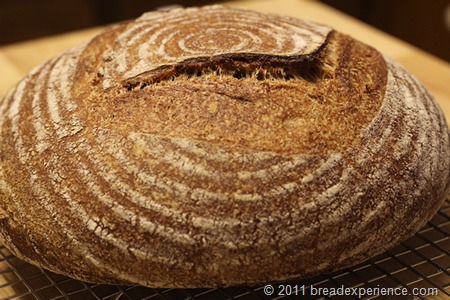
Enjoy: Let the loaf cool completely before slicing and serving.
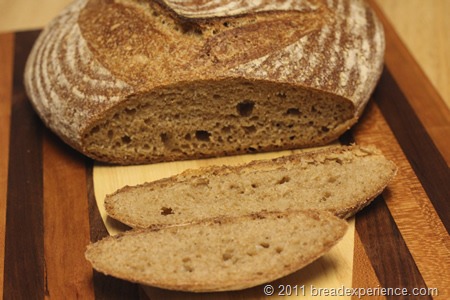
Thank you for joining me for World Bread Day. Come let us break bread together.
World Bread Day was started by the International Union of Bakers and Bakers-Confectioners (IUB) as a time to talk about the importance of bread, as well as its history and future.
Zorra adopted World Bread Day as a (food)blogger event in 2006 and the event has been celebrated by bread bakers around the world every year since then. Take a look at the previous World Bread Day Roundups. You’ll be amazed at the creativity of all of the bakers around the world.
I love to talk about bread so I jumped right on the bread-baking bandwagon. This is my third year participating in World Bread Day.
Happy Baking!
Cathy
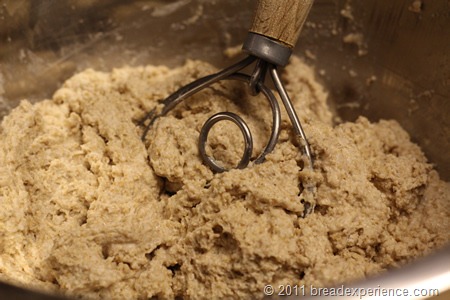
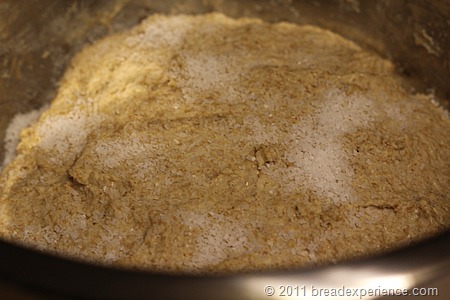
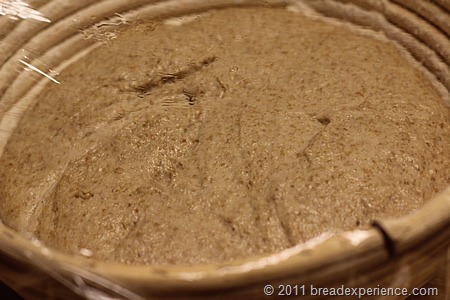
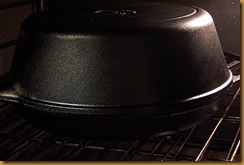
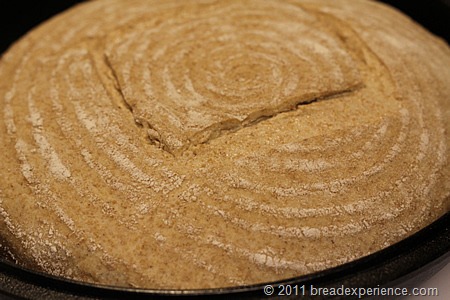

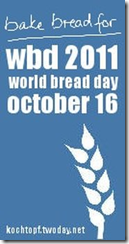
Judd @Weekendloafer says
Great looking bread,photos and write up…
I have to admit.. have not tried any of Chad’s recipes yet…I will try this one!
Judd@Weekendloafer says
Great looking bread,photos and writeup…
i have to admit…I have not tried any of his recipes yet…I will try this one…on my list..
Cathy (breadexperience) says
Thanks Judd! You do need to try this one! Didn’t you get the book awhile back? Lol…
zorra says
A perfect loaf! And I love the poem! Thank you for participating in World Bread Day 2011.
Gwen says
Wow, that’s one gorgeous loaf of bread!
Cathy (breadexperience) says
Thanks Gwen! I really like the Tartine method.
i wnt ur loaf says
i want ur loaf in my mouth xoxoxox
Kathy says
Hi Cathy,
Great pictures and process documentation.
A couple of questions.
Are you using a 5qt combo baker or a 3?
I noticed you mentioned cutting the dough in half during shaping but at the top of the recipe it says makes one 2lb loaf.
Does 500gr of flour make one 2 lb loaf or two?
I am still trying to figure out the process to make Tartine bread using Ancient grains. Thank you for the help.
Kathy
Cathy says
Hi Kathy, thanks for visiting my blog and commenting. These are all great questions!
I use the 3.2 quart combo baker with the 10.25-inch shallow skillet/lid. The formula that I included on this post makes one 2 lb loaf. I do see why you were confused. I have updated the instructions. I do hope everything makes sense now.
Do let me know how it goes if you make this bread.
Happy Baking!
Cathy
Kathleen says
I want to try this recipe, but I have a question. in the opening paragraph you describe this bread as “50/50 blend of whole wheat and white all-purpose flour”, but the recipe calls for “350 grams whole wheat flour and 150 grams all-purpose flour (I used a 50/50 blend of whole wheat and white all-purpose flour).”
Please clarify. Thank you.
Cathy says
Hi Kathleen, when you add the 350 grams of whole wheat flour and the 50% whole wheat in the 150 grams of 50/50 AP/whole wheat flour blend, this is actually more like an 85% whole wheat bread. I edited the intro to reflect this. Hope this helps.
Kathleen Dobek says
Thank you. I’m ready to add flour to my overnight leaven right now.It’s my first time to make the country loaf, and I’m looking forward to this whole wheat version.
Cathy says
Let me know how it goes. Happy Baking!